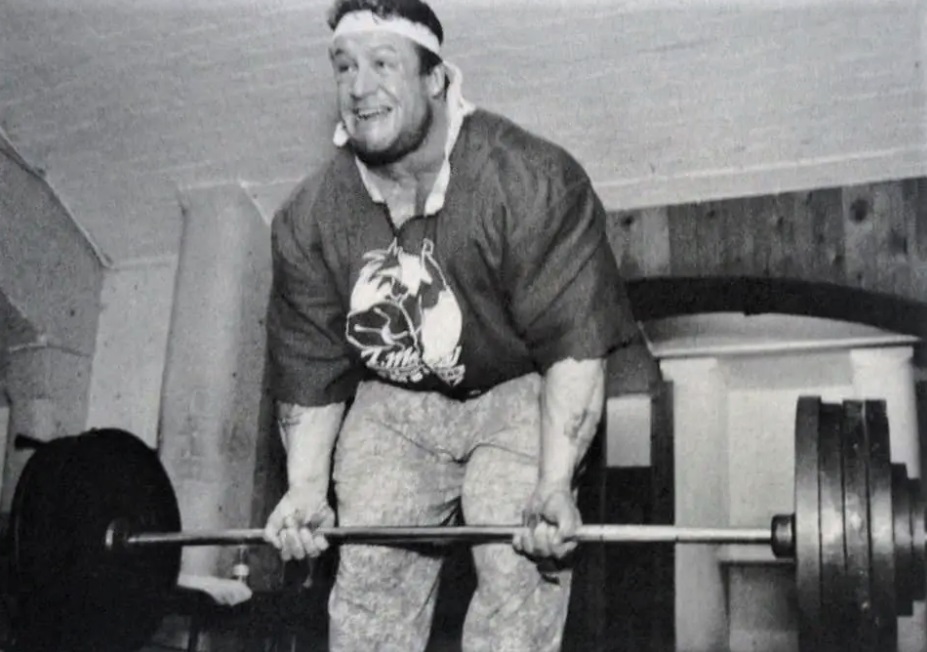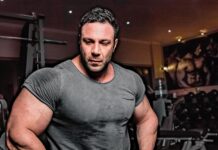Kevin Horton
How strong was Dorian Yates? Diesel was always getting stronger. For as long as he was training for bodybuilding competitions, and until injuries halted his progress, the six-time Mr. Olympia (1992-97) was in his dungeon gym in Birmingham, England, striving to beat his logbook. An adherent of high-intensity training, this HIT man performed a minimum number of working sets (typically one per exercise) with maximum weights, usually for 8-10 reps, including, when possible, with one or two forced reps. Yates chronicled his typical Olympia-reign weights in his book, A Warrior’s Story. With others, you have to take their professed PRs with a shaker of salt, but Dorian wasn’t out to impress with inflated numbers. And those numbers align with the video, photo, and eyewitness evidence. In fact, sometimes that evidence proves an even bigger number. We examined it all to determine just how strong Dorian Yates was.
Dorian Yates used strict form, full ranges-of-motion (unless otherwise noted), and went at a slow, controlled pace, usually emphasizing the negative halves of reps, all of which made lifts more difficult but, he believed, more effective.
DORIAN YATES: THE POWERLIFTS
Dorian Yates built two of the best legs of the ’90s without squatting. Well, this is partially true. He squatted for his first few years of training, until he determined he could grow his quads better and relieve his persistent knee pain with other exercises. Chronicled in a journal entry on March 1, 1985, when he weighed 230, he squatted 405 for seven followed by 425 for four. The former equates to a 486 lb. squat for one rep. Two days later, he benched 310 x 5, which equates to a 350 lb. bench press for one rep. But he was only 22 and had been training for less than two years. He would be approximately 50% stronger a decade later during his Olympia reign when the squat and bench press were no longer included in his routines. Projecting a 50% gain in Dorian Yates’ 1985 squat would raise it to 729 lbs. for a single rep, and a similar gain in his one-rep bench press would put it at 525 lbs.
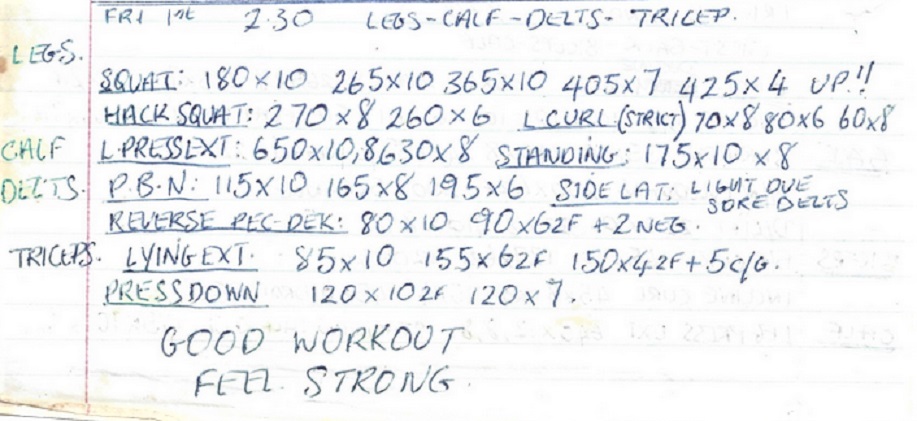
Conversely, the deadlift wasn’t in Yates’ early training, but it was in his Olympia-era workouts. However, he then deadlifted last in his back routines. Furthermore, he avoided lowering the bar all the way to the floor, thus minimizing quad and glute action and keeping more tension on his back. These factors make deadlifts considerably harder. In a 1996 video, we see him deadlifting 455 x 6 with straps, which equates to a 529 lb. deadlift. But that was the final exercise in his back workout, which included 405 lb. rows, and it was directly preceded by weighted hyperextensions, which pre-exhausted his spinal erectors. So, we don’t know how much Yates could’ve deadlifted powerlifting-style under ideal conditions when at his strongest.
BACK
The six-time Mr. O revolutionized back thickness and width. This was a typical Yates training routine: Nautilus machine pullovers (440 lbs.), Hammer Strength machine underhand pulldowns (320 lbs.), barbell rows (435 lbs.), one-arm Hammer Strength machine rows (245 lbs. per side). He then did Hammer Strength machine rear flyes (55 lbs. per side) and seated bent-over dumbbell raises (90-lb. dumbbells), both for rear delts, and finished with hyperextensions (40 lbs.) and continuous-tension deadlifts (455 lbs.), for his spinal erectors. All of these exercises were for 6-10 reps, except the hypers, which were 10-12.
But back to the barbell rows. This is the exercise most associated with Dorian Yates, first because he did them in a more upright style (torso approximately 45 degrees), and secondly because he did them with a shoulder-width, underhand grip—until he tore his left biceps nine weeks before the 1994 Olympia. After that, for the final three years of his Olympia reign, he typically did them in the traditional overhand-style (though still more upright). He has an overhand grip when he’s barbell rowing 405 for six reps in the Blood and Guts video, shot in 1996. But in the photo at the top of this page, shot before the 1994 injury, he’s rowing 435 underhand, presumably for 6-8 reps. Note also that Yates did all his rowing after pre-exhausting his lats with pullovers and pulldowns.
CHEST
In an interview, Dorian Yates claimed he was “doing 500-pound decline presses as my main chest exercise” until he experienced shoulder problems. After that, his typical chest routine was: incline barbell presses (425 lbs.), Hammer Strength machine bench presses (350 lbs.), and incline dumbbell flyes (110-lb. dumbbells), all for 6-10 reps, and he finished with cable crossovers (90 lbs. per side) for 10-12. It’s difficult to say how many reps of the incline barbell presses, the 6-time Mr. O got on his own in the Blood and Guts video because his partner kept his fingers touching the bar, but we’ll say four good reps and two forced reps. Four equates to one-rep with 442 in the incline press and a 520-lb. bench press.
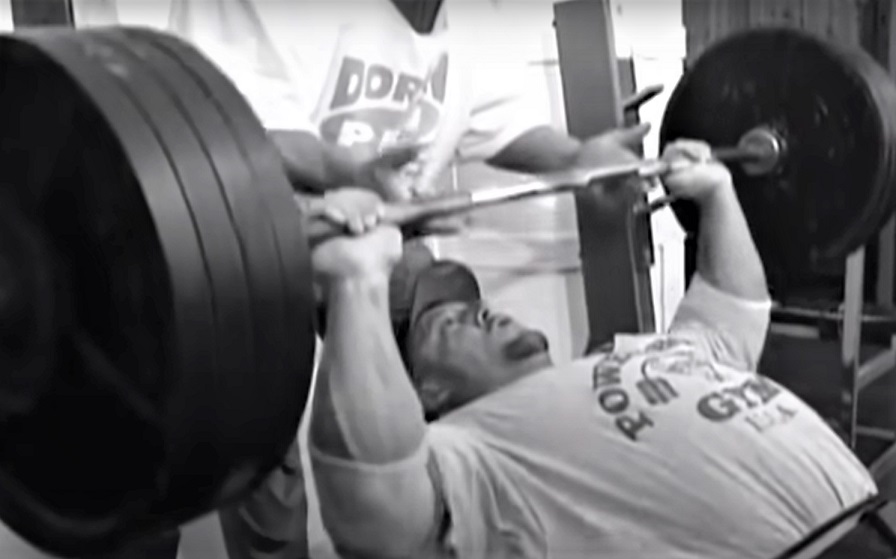
BICEPS
Bi’s were trained after pecs, and Yates did incline dumbbell curls (70-lb. dumbbells), EZ-bar curls (155 lbs.), and one-arm Nautilus machine curls (120 lbs.), all for 6-8 reps, including forced reps.
SHOULDERS
Dorian Yates trained front and side delts before trapezius. (As stated above, he worked rear delts on back day.) For delts, he did Smith machine presses (340 lbs.), seated dumbbell side laterals (70-lb. dumbbells), and one-arm cable side laterals (70 lbs. per side), all for 8-10 reps. He followed that with shrugs with 185-lb. dumbbells for 10-12 reps. Note that in the following photo of doing barbell shrugs, circa 1994, he’s using 595 lbs.
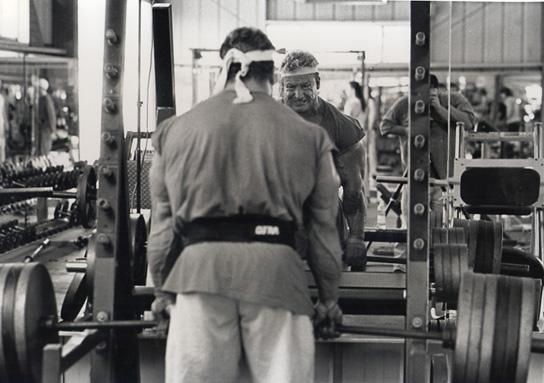
TRICEPS
Tri’s followed shoulders with pushdowns (180 lbs.), lying EZ-bar extensions, a.k.a. skullcrushers (155 lbs.), and one-arm pushdowns (70 lbs.), all for 8-10 reps, including forced reps.
QUADRICEPS
After Yates dropped squats from his quad routine, the focus turned to three exercises: leg extensions (270 lbs.) for 10-12, 45-degree leg presses (1265 lbs.) for 10-12, and hack squats with a narrow stance (660 lbs.) for 8-10 reps. In Blood and Guts, he used roughly that amount on leg presses for 11 reps. If some of these numbers sound “light” compared to the man who followed him as Mr. Olympia, Ronnie Coleman, note that Yates did much fuller, slower reps than Coleman, especially on the leg presses. Of course, Coleman was a strength freak, but, so, to an only slightly lesser degree, was Yates.
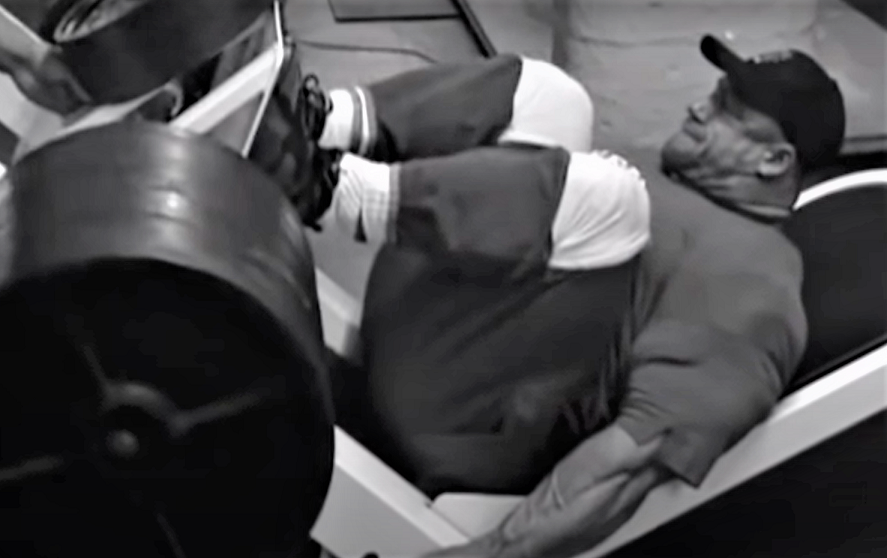
HAMSTRINGS
His focus was on three exercises: lying leg curls (180 lbs.), stiff-leg deadlifts, lowering the bar to just below his knees (365 lbs.), and one-leg curls (50 lbs. per side), all for 8-10 reps.
CALVES
Dorian Yates had the best calves ever seen on a Mr. Olympia. In his 1998 book, he claimed to go up to 1300 pounds on standing calf raises for 10-12 slow reps. That seems unbelievable, but it’s backed by eyewitnesses and video evidence. We can see him piling plates atop a calf machine with a very big stack—and the pin is set at the bottom—in the Blood and Guts video. Following that, he did seated calf raises with 250 for 10-12 reps.
DORIAN YATES STRENGTH RESOURCES
Blood and Guts: The Ultimate Approach to Building Maximum Muscle (book) by Dorian Yates and Bob Wolff, 1993.
Blood and Guts (Dorian Yates training video) directed and produced by Kevin Horton, 1996.
A Warrior’s Story: A Portrait of Dorian Yates (book) by Dorian Yates and Peter McGough, 1998.
Flex magazine, various Dorian Yates articles, 1993-98.
“Dorian Yates Discusses Bodybuilding Training: Never-Before Published Insights,” interview by David Robson, bodybuilding.com, 2019.
Dorian Yates Training Journal: The Official Journal Of A 6x Mr. Olympia Winner (eBook) by Dorian Yates, 2019.
Related content:
Dorian Yates Workout: Complete Guide
HIT MEN: The Story of High-Intensity Training
How Strong was Ronnie Coleman?
Dorian Yates ranked #5 on Best Bodybuilders of All Time, According to A.I.



































